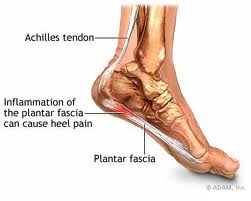To start the year off right, I received a request to discuss plantar fasciitis.
I think some basic anatomy will help explain how this painful injury begins and how it is treated. The plantar fascia is a tendon-like structure (fascia) that runs under the foot supporting the arch. It is an extension of the achilles tendon, which in turn is an extension of the calf tendon. Minor or major tears on this fascia is the fasciitis part of the injury.
The injury is typically caused by tight calves (most athletes experience this), or an overuse/over stretch of the arch in the foot. Improper foot wear, lack of conditioning/stretching, and overuse can be the biggest mechanisms. When I mention improper footwear, I am referring to old running shoes, unsupportive running shoes, and even dress shoes with a hard insole.
The best way to approach foot pain is to deal with it right away. Plantar fasciitis typically causes pain on the medial (inside) part of the heel, right where the arch begins. Stretching your calves can help stop small tears from growing. Checking your footwear at the first sign of pain is critical.
Plantar fasciitis can become quite painful causing difficulty walking, running, and limit activities of daily living. If your foot pain gets to this level seek medical intervention. Getting an x-ray to clear any bony abnormalities and a diagnostic ultrasound to examine the soft tissue is vital.
Therapy is needed to reduce swelling and pain, as well as promote healing to the area. The sooner you seek intervention the less damage you will cause. Some ways you can help at home include:
- Night splints (socks that keep your fascia on stretch)
- Compression socks
- Wearing running shoes in the house
- Getting out of bed into warm, supportive footwear (to reduce the shock of a cold floor and collapse of the arch)
- Foot exercises
Strengthening of the foot is important for healing but also as a preventative measure. Athletes take for granted the strength of their feet, which are lifelines for sport. Calf strengthening exercises include the exercises given in my last blog about ankle weakness.
Simple foot exercises include picking up pens with your toes and towel scrunches. In your bare feet scrunch a towel up using just your toes keeping your heel on the floor. Once the pain is manageable and you are no longer limping, the stork stance is very helpful.
You can ice your foot with an old plastic water bottle. Fill the bottle with water and place it in the freezer. Once frozen, roll the bottle under your foot.
If you have any questions or concerns, please contact me. Have a great 2013 and keep those feet happy!!
Jen Mark BSc., CAT(C), CSCS





I believe you can do the same exercises with a golf ball?
You can do the massage part with the golf ball. The water bottle only allows you to ice the area for inflammation. By doing the light massage at the same time, you can get the ice a little deeper than just using an ice pack. But the golf ball works well if the area isn’t painful to the touch.
Hi Jen, I like the information and the simple treatment tips. Forwarded to my sister-in-law who will benefit. What’s you opinion on Radial Pulse Wave (shockwave) as a treatment for a chronic condition?
Shockwave is excellent, just so expensive. I believe shockwave is best as the last resort or for a very severe case. It only takes a few treatments to work which is nice!
Reblogged this on Institute of Geriatric Care & Research.